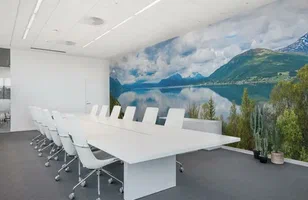Over the past decade, digital printing technologies have rapidly advanced, allowing for high-quality, digitally printed wallpaper. Digital printing relies on inkjet or toner-based printing methods to place ink directly onto the wallpaper substrate without the need forscreen-printing. This makes it possible to efficiently print short-run and customized wallpaper designs on demand.
Some key digital printing technologies used for wallpaper include
– Inkjet printing – Drops ink onto the substrate in the form of tiny droplets. This allows for highly detailed, full-color printing and layering of different inks. Various inkjet printers optimized for Digitally Printed Wallpaper include roll-fed and flatbed printers.
– Toner printing – Uses an electrostatic process to transfer dye or pigment in powdered form (toner) onto the substrate to form the image. Toner printers tend to have higher output speeds than inkjet.
– Digital embossing – Adds tactile textures and dimension by pressing patterns or images into the wallpaper surface after printing. This can enhance designs with unique visual and physical effects.
Benefits of Digital Wallpaper Versus Traditional Methods
The rise of digital printing has provided several advantages over traditional analog wallpaper production methods like screen and roller printing:
Customization and Variety
Digitally printed wallpaper allows for infinite customization and variety compared to traditional methods. Designs can easily be modified on demand and short runs of unique designs are cost-effective. This has opened up opportunities for architects, designers and consumers to have truly bespoke wallpapers for their projects.
Rapid Production Timelines
The Digitally Printed Wallpaper can print designs on rolls of paper without needing to produce screens or printing plates first. This dramatically shortens production timelines from design to finished product. Wallpaper can often be produced and shipped within days or weeks versus months.
Reduced Material Waste
Since digital printing only puts ink where it is needed without utilizing screens, plates or cylinders, there is minimal material waste generated during production. Any unused substrate and ink can simply be reused. This improves sustainability versus analog processes.
More Vibrant and Detailed Imagery
The print resolution of digital wallpaper printers, often around 1440 dpi or higher, allows for incredibly detailed and vibrant reproduction of photographic images and complex illustrative designs. Fine textures, gradients and realistic scenes can be effortlessly rendered.
Cost Savings with Scalability
While initial investment in digital printing equipment is higher, once upgrades are paid off the cost per yard printed decreases significantly as production scales up. There are no recurring costs associated with screens or plates, so small-to-large production runs have lower per unit costs versus traditional methods.
Driving the Custom Home
The ability to offer limitless customization at reasonable minimum order quantities has been a major driver of growth within both the residential custom home and commercial interior design.
Custom Homes
Homeowners want their new builds and remodels to have uniquely tailored interior schemes reflective of their personal style. Digitally printed wallpaper has allowed architects, designers and flooring/wallcovering contractors to meet this demand. Entire collections showcasing architectural detail, landscape photography or custom graphics can now be created for one-off projects.
Commercial Interiors
For office buildings, retail stores, restaurants and other commercial spaces, wallpaper is frequently used as a decorative surface or design element within a specific branded environment. Digital printing makes it practical and affordable to fabricate wallpapers displaying logos, original artwork concepts or photography accurately representing a company’s visual identity. Entire murals, photo walls and textured accent walls can transform interior spaces.
Expanding Range of Substrates
Digitally printed wallpaper technologies continue advancing to support production on an expanding range of substrate materials beyond just traditional non-woven and vinyl-coated papers:
– Textiles like fiberglass, wool, cotton and synthetic blends allow for unique woven or textural wallpaper designs.
– Thin, lightweight papers or films make removable, repositionable wallpaper possible for renters and do-it-yourself decor changes.
– Rigid materials such as boards, panels, tiles or mounted canvases enable dimensional, three-dimensional wall art applications beyond just wall covering.
– Eco-friendly substrates utilizing recycled content, rapidly renewable sources or lower VOC binders/coatings match increasing demand for sustainable interiors.
The digitally printed wallpaper experienced an estimated 10-15% annual growth rate between 2015-2020 and shows no signs of slowing according to research firms. Younger design-focused consumers and multifamily developments will continue fueling customization trends. As production capacities increase and technologies enable even more substrate versatility, the potential applications for digital wallpaper seem limitless. Interactive capabilities may also emerge, merging wallcovering, lighting and smart surfaces. Overall, digital printing looks positioned to become the dominant wallpaper production methodology worldwide in the next 5-10 years.
*Note:
1. Source: Coherent Market Insights, Public sources, Desk research
2. We have leveraged AI tools to mine information and compile it




